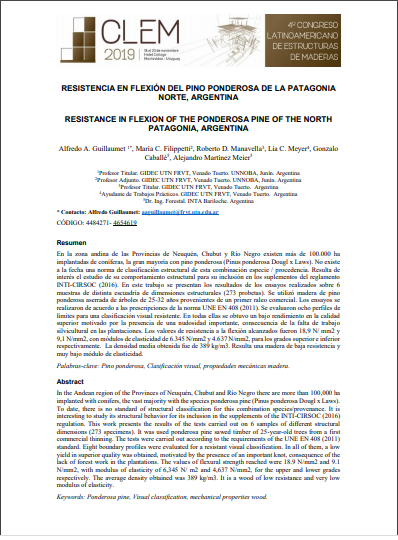Ver ítem
- xmlui.general.dspace_homeCentros Regionales y EEAsCentro Regional Patagonia NorteEEA BarilochePresentaciones a Congresosxmlui.ArtifactBrowser.ItemViewer.trail
- Inicio
- Centros Regionales y EEAs
- Centro Regional Patagonia Norte
- EEA Bariloche
- Presentaciones a Congresos
- Ver ítem
Resistencia en flexión del Pino Ponderosa de la Patagonia Norte, Argentina
Resumen
En la zona andina de las Provincias de Neuquén, Chubut y Río Negro existen más de 100.000 ha implantadas de coníferas, la gran mayoría con pino ponderosa (Pinus ponderosa Dougl x Laws). No existe a la fecha una norma de clasificación estructural de esta combinación especie / procedencia. Resulta de interés el estudio de su comportamiento estructural para su inclusión en los suplementos del reglamento INTI-CIRSOC (2016). En este trabajo se presentan los
[ver mas...]
En la zona andina de las Provincias de Neuquén, Chubut y Río Negro existen más de 100.000 ha implantadas de coníferas, la gran mayoría con pino ponderosa (Pinus ponderosa Dougl x Laws). No existe a la fecha una norma de clasificación estructural de esta combinación especie / procedencia. Resulta de interés el estudio de su comportamiento estructural para su inclusión en los suplementos del reglamento INTI-CIRSOC (2016). En este trabajo se presentan los resultados de los ensayos realizados sobre 6 muestras de distinta escuadría de dimensiones estructurales (273 probetas). Se utilizó madera de pino ponderosa aserrada de árboles de 25-32 años provenientes de un primer raleo comercial. Los ensayos se realizaron de acuerdo a las prescripciones de la norma UNE EN 408 (2011). Se evaluaron ocho perfiles de límites para una clasificación visual resistente. En todas ellas se obtuvo un bajo rendimiento en la calidad superior motivado por la presencia de una nudosidad importante, consecuencia de la falta de trabajo silvicultural en las plantaciones. Los valores de resistencia a la flexión alcanzados fueron 18,9 N/ mm2 y 9,1 N/mm2, con módulos de elasticidad de 6.345 N/mm2 y 4.637 N/mm2, para los grados superior e inferior respectivamente. La densidad media obtenida fue de 389 kg/m3. Resulta una madera de baja resistencia y muy bajo módulo de elasticidad.
[Cerrar]
In the Andean region of the Provinces of Neuquén, Chubut and Río Negro there are more than 100,000 ha
implanted with conifers, the vast majority with the species ponderosa pine (Pinus ponderosa Dougl x Laws).
To date, there is no standard of structural classification for this combination species/provenance. It is
interesting to study its structural behavior for its inclusion in the supplements of the INTI-CIRSOC (2016)
regulation. This work presents
[ver mas...]
In the Andean region of the Provinces of Neuquén, Chubut and Río Negro there are more than 100,000 ha
implanted with conifers, the vast majority with the species ponderosa pine (Pinus ponderosa Dougl x Laws).
To date, there is no standard of structural classification for this combination species/provenance. It is
interesting to study its structural behavior for its inclusion in the supplements of the INTI-CIRSOC (2016)
regulation. This work presents the results of the tests carried out on 6 samples of different structural
dimensions (273 specimens). It was used ponderosa pine sawed timber of 25-year-old trees from a first
commercial thinning. The tests were carried out according to the requirements of the UNE EN 408 (2011)
standard. Eight boundary profiles were evaluated for a resistant visual classification. In all of them, a low
yield in superior quality was obtained, motivated by the presence of an important knot, consequence of the
lack of forest work in the plantations. The values of flexural strength reached were 18.9 N/mm2 and 9.1
N/mm2, with modulus of elasticity of 6,345 N/ m2 and 4,637 N/mm2, for the upper and lower grades
respectively. The average density obtained was 389 kg/m3. It is a wood of low resistance and very low
modulus of elasticity.
[Cerrar]

Autor
Guillaumet, Alfredo Anibal;
Filippetti, María Cecilia;
Manavella, Roberto Daniel;
Meyer, Lia Caren;
Caballe, Gonzalo;
Martinez Meier, Alejandro;
Fuente
4° Congreso Latinoamericano de Estructuras de Maderas. Montevideo, Uruguay 18 al 20 de Noviembre de 2019
Fecha
2019-11
Formato
pdf
Tipo de documento
documento de conferencia
Palabras Claves
Derechos de acceso
Abierto
 Excepto donde se diga explicitamente, este item se publica bajo la siguiente descripción: Creative Commons Attribution-NonCommercial-ShareAlike 2.5 Unported (CC BY-NC-SA 2.5)
Excepto donde se diga explicitamente, este item se publica bajo la siguiente descripción: Creative Commons Attribution-NonCommercial-ShareAlike 2.5 Unported (CC BY-NC-SA 2.5)


